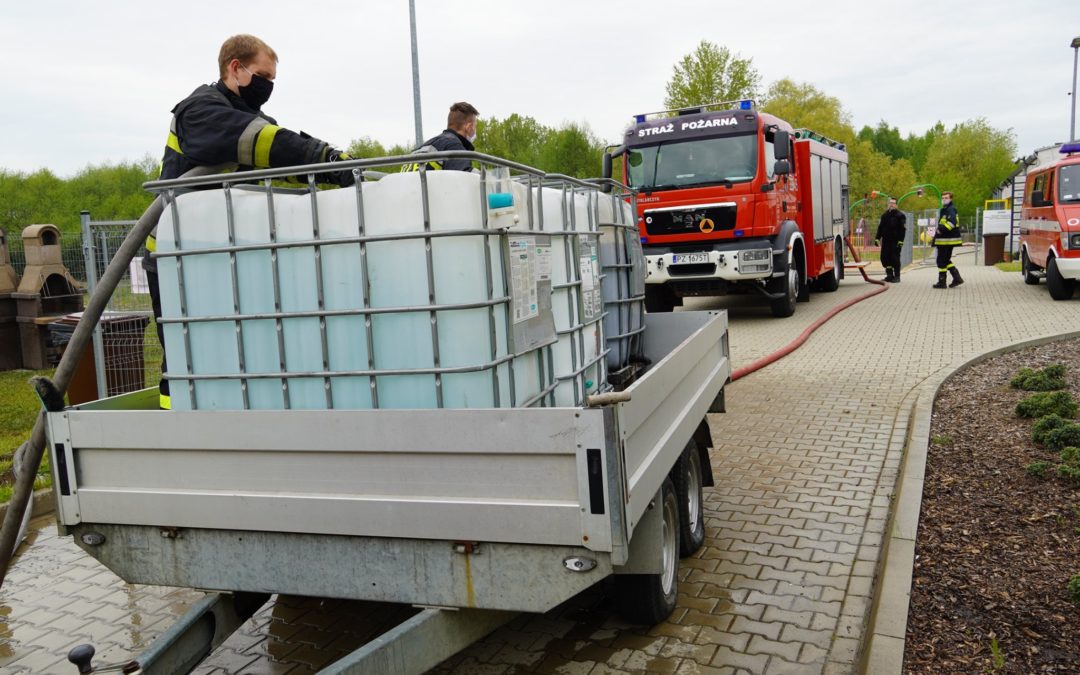As Poland faces severe water shortages, caused by one of its worst droughts in over a century and years of mismanagement, cites have been forced to adapt. Some have been diverting water from swimming pools, while others are finding ways to improve rainwater retention and encourage citizens to change their gardening habits.
A long spell of dry weather has resulted in water supplies becoming dangerously scarce: the Vistula river, which runs through the capital Warsaw, has been running low for weeks, with the water level dropping 25cm in the space of a fortnight, according to TVN24.
In July last year, which was Poland’s hottest on record, the level of the river in Warsaw fell to its lowest ever level of 34cm. By 14 April this year, however, the level at one spot in the capital was already 26cm lower than on the same day in 2019.
Took a trip to Warsaw’s own Aral Sea today. Water levels in the Vistula river have been spectacularly low this spring following a dry winter. pic.twitter.com/Jbd9Xflk2Q
— Maria Wilczek (@mariawilczek) April 25, 2020
At the end of last month, Polish President Andrzej Duda appealed to the public and Polish farmers to act “rationally” in their use of water in order to maintain supplies for the remainder of the year. He also promised farmers – who are particularly affected by water shortages – that they would receive state support.
Among various measures to be taken by the government in response to the crisis, Duda announced that nine large storage reservoirs are to be built, as well as 30 smaller ones.
In the meantime, cities and communities have already been trying to adapt to the dry conditions, including implementing some schemes that take advantage of the coronavirus lockdown.
in Warsaw’s Praga district, water from the Prawy Brzeg swimming pool, which has not opened since the onset of the pandemic, will be used to wash the streets and water local plantlife. It will be pumped out by firefighters, reports Gazeta Wyborcza.
A similar scheme was implemented in the village of Koziegłowy earlier this week, with the Akwen pool donating its 600,000 litres of water to the local community. After the water was cleaned, firefighters spent six hours distributing it to residents and farmers, for use in gardens and agricultural plots.
Pływalnie z powodu pandemii stoją puste, ale woda nie musi się marnować.
Szczegóły w materiale:https://t.co/nTWUlDRC6x
— Fakty TVN (@FaktyTVN) May 5, 2020
The city of Kielce, meanwhile, is preparing to implement a rainwater-retention scheme, which would see residents given funding for the purchase and installation of tanks for collecting rainwater or snowmelt and the construction of absorbent wells, among other equipment.
In response to the water shortages last year, Gdańsk became the first city in Poland to launch a similar initiative, with groundwater gardens and retention parks, reports SmogLab, an environmental organisation.
“Taking ecological action in this area is a must…[when] Poland is threatened by record drought,” Kielce mayor Bogdan Wenta told Onet. “The implementation of this project will be an important step to increasing the city’s resistance to extreme meteorological and hydrological phenomena…This is justified both ecologically and economically.”
There have also been calls across Poland for citizens to reduce mowing of lawns, with longer grass and plants reported to improve soil moisture. In Poznań, a local “Green Coalition” has proposed municipal lawns with urban meadows, to avoid the need for mowing altogether.
As part of its drought prevention program, the city of Łódź has offered advice for residents on how to manage water use when taking care of their gardens, reports Gazeta Wyborcza.
The ongoing drought this spring has also posed a threat to wildlife. Last month, State Forests, the state-owned forest management company, put nearly the entire forest cover under red alert, meaning “high forest fire danger”.
Biebrza National Park, the largest in Poland, suffered its worst fire in decades, most likely started by farmers illegally burning grass and then exacerbated by the dry conditions. The blaze lasted for a week and damaging 5.3 hectares of valuable habitat home to rare animals.
In Wrocław, a city in western Poland, water troughs have been set up in 25 parks across the city for bees and small birds, according to Gazeta Wyborcza. Residents have also diverted water from a construction site to fill a pond in the Maślice district, which is a habitat for wildlife, reports Wirtualna Polska.
Though Poland has experienced a bout of rain in recent days, experts are warning that this is not enough to avoid dry conditions, with soil moisture still not returning to normal levels. Poland’s state meteorological service, IMGW-PIB, has warned that river stations across Poland are still reporting low flow and water levels, with the risk of drought persisting.
Na zobrazowaniach dotyczących wilgotności gleby widać gdzie padał deszcz. 🔍
Poprawę warunków wilgotnościowych widać w warstwie 0-7 cm. Głębiej jest gorzej.🙄
Obszary niedoboru pokrywają się w dużej mierze z występowaniem suszy hydrologicznej. ✅#IMGW #susza #drought #stopsuszy pic.twitter.com/1gDeozeTMP— IMGW-PIB METEO POLSKA (@IMGWmeteo) May 7, 2020
Main image credit: Centrum Rozwoju Kultury Fizycznej AKWEN/Facebook

Juliette Bretan is a freelance journalist covering Polish and Eastern European current affairs and culture. Her work has featured on the BBC World Service, and in CityMetric, The Independent, Ozy, New Eastern Europe and Culture.pl.




















